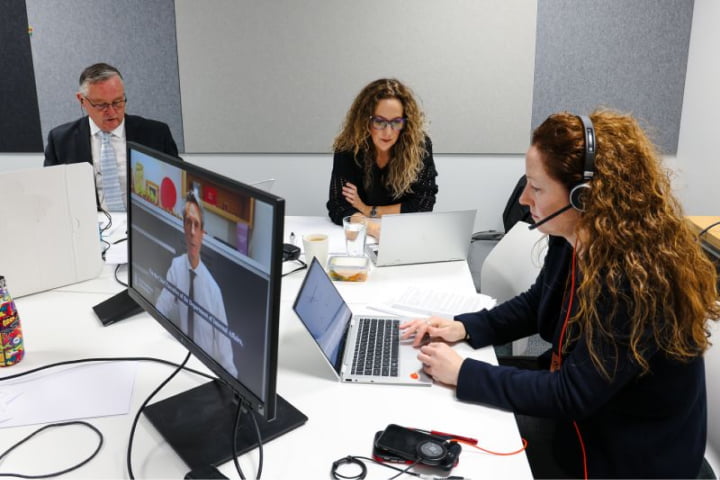To celebrate Techweek , the Digital Public Service (DPS) branch hosted 2 online events — on and . The webinars highlighted initiatives within DPS and across government, that are helping agencies to provide digital services for New Zealanders.
Across both sessions, the speakers highlighted how vital public trust and confidence is when the government is offering new digital services. By putting the users of these initiatives at the centre, agencies can ensure they meet people’s needs and provide choice around how to better interact with government agencies.
The presentations and following Q&A for both sessions emphasised how quickly new digital tools and services are emerging. As such, it was important for agencies to be aware of these advancements and react quickly and work collaboratively, to find the best solutions to key issues regardless of the technologies being used.
Session 1 — ‘Digitising government and the role of the GCDO’
In this session, speakers gave examples of the work of the Government Chief Digital Officer (GCDO) and the DPS team.
These teams help government agencies to do digital well — from the tools they choose, to the rules and standards they work to. Along with setting the direction, the GCDO and the DPS also support agencies to get the best value through smart investment choices.
The session highlighted the:
- work to support agencies to responsibly use Artificial intelligence (AI)
- establishment of the Digital Identity Trust Services Framework (DITSF) — Trust framework for digital identity
- ongoing work of the All-of-Government (AoG) portfolio of digital products and ICT services — Products & services.
Q&A topics — responsible AI, design standards, accessibility, security and privacy
During the Q&A we discussed how:
- to implement AI responsibly, including issues of bias and deep fakes
- the DISTF enables people to opt in to new digital identity services
- common design standards can make government services more accessible
- online government services can ensure security and privacy is built in.
‘Trust and choice’ are recurring themes
Across the discussion, trust and choice were key recurring themes, and seen as critical to enable confidence in new digital services. To ensure these new services were both trusted and useful, the speakers discussed how the GCDO can support government agencies to consider issues of accessibility, security and risk, and interoperability.
Session 2 — ‘Digital government services anywhere’
In this session, presenters from Health NZ — Te Whatu Ora, Kāinga Ora and Ministry of Business, Innovation and Employment (MBIE), discussed initiatives from across government that help people to access government services and support — no matter where they’re located.
Presenters and their digital services
Health NZ — Te Whatu Ora
The Hira programme’s National Event Management Service (NEMS) — which updates health service providers and other entities, as appropriate, when the status of a patient changes.
The Piki Te Ora app — where people can update their health status in real time and receive tailored care related to changes in their situation.
Piki Te Ora — Health NZ — Te Whatu Ora
A prototype AI transcription service being developed by the Piki Te Ora team — to support health professionals with clinical note taking.
These services help patients to receive timely care, and support health clinicians to more quickly prepare and access patient records.
Kāinga Ora — Homes and communities
MyKāingaOra — trial of a new app-based service which helps residents to self-manage information about their homes.
The trial highlighted the need for digital connectivity as well as new tools.
MyKāingaOra — kāingaora.govt.nz
Ministry of Business, Innovation and Employment (MBIE)
FormBuilder — this service enables agencies to quickly create robust and valuable low-code and no-code web forms, to improve access to services.
- FormBuilder.govt — Helping government agencies develop online forms quickly and efficiently
- Build your forms — businessconnect.govt.nz
Make access to government services easy for all
Common across these diverse presentations was the drive to make accessing government services as easy as possible for people — regardless of their data plan, their device, or where they lived.
Presenters discussed how important it was to:
- include the end-users as part of the development
- take the time to fully understand users’ concerns and address their needs — to ensure the services delivered are valuable and trustworthy.
A great example of this was what Kāinga Ora learnt when trialling their new app for residents. They realized there was not just a need for an app, but also access to mobile data to use government services online. By linking their app to Zero Data, Kāinga Ora could more easily support residents. Connecting these different initiatives will continue to improve the experience of government for New Zealanders.
Digitising government
New Zealanders should be able to access government services in ways that work for them. The GCDO is working to connect different services and initiatives, to help realise the economic and societal benefits and provide better service experiences to all New Zealanders — such as the ones presented at these 2 Techweek sessions.
Embracing change and recognising the opportunities that digital modernisation brings, like collaboration, flexibility, innovation, and data-driven decision-making, is key. The GCDO helps support agencies to accelerate their development of modern and digital services.
In doing so, New Zealanders’ experience of government services is positive, rewarding and supports them to quickly get what they need, when they need it.
Cabinet paper: Accelerating the digitising of government services — DIA [PDF 1.2MB]
Techweek team: Erika Pearson, Grant Carpenter and Tanya Hossein. Thanks to the presenters and attendees.

Published

